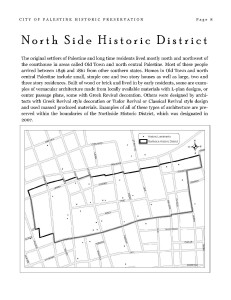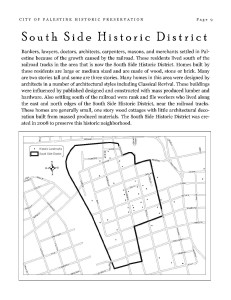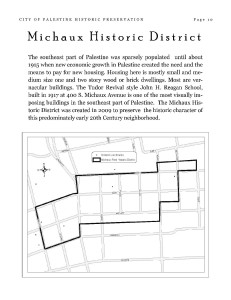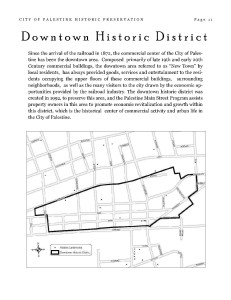
City of Palestine Historic Landmark Plaque
THE FOUR PALESTINE, TEXAS RECOGNIZED HISTORICAL DISTRICTS:
1. Palestine North Side Historic District:
The original settlers of Palestine and long time residents lived mostly north and northwest of the courthouse in areas called Old Town and north central Palestine. Most of these people arrived between 1846 and 1861 from other southern states. Homes in Old Town and north central Palestine include small, simple one and two story houses as well as large, two and three story residences. Built of wood or brick and lived in by early residents, some are examples of vernacular architecture made from locally available materials with L-plan designs, or center passage plans, some with Greek Revival decoration. Others were designed by architects with Greek Revival style decoration or Tudor Revival or Classical Revival style design and used massed produced materials. Examples of all of these types of architecture are preserved within the boundaries of the Northside Historic District, which was designated in 2007.” -City Historical Preservation Committee Handbook
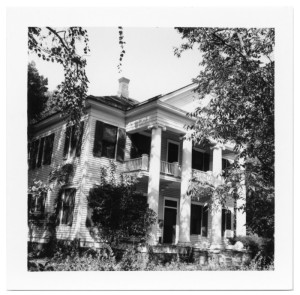
Classical Revival-style Home on Cedar St. in Palestine’s North Side Historic District. Image Credit: The Portal to Texas History, Image Circa 1979.
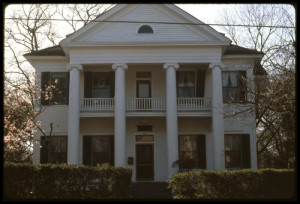
Circa 1991, The Same Home on N. Cedar Street in Palestine. The dominant architectural feature is the front portico with its 2 story Ionic columns. The building remains virtually unaltered with its historic integrity intact.
2. Palestine South Side Historic District:
“Bankers, lawyers, doctors, architects, carpenters, masons, and merchants settled in Palestine because of the growth caused by the railroad. These residents lived south of the railroad tracks in the area that is now the South Side Historic District. Homes built by these residents are large or medium sized and are made of wood, stone or brick. Many are two stories tall and some are three stories. Many homes in this area were designed by architects in a number of architectural styles including Classical Revival. These buildings were influenced by published designed and constructed with mass produced lumber and hardware. Also settling south of the railroad were rank and file workers who lived along the east and north edges of the South Side Historic District, near the railroad tracks. These homes are generally small, one story wood cottages with little architectural decoration built from massed produced materials. The South Side Historic District was created in 2008 to preserve this historic neighborhood.” -City Historical Preservation Committee Handbook
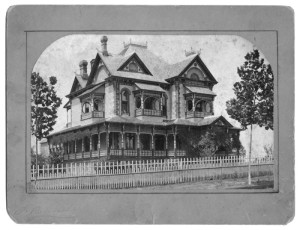
The glorious Queen-Anne Victorian Style Broyles House at 1305 S. Sycamore as seen circa 1900.
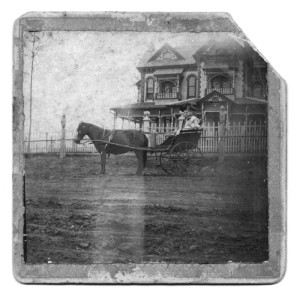
Photograph of the Broyles in a buggy circa 1896, in front of the Broyles Home, located at 1305 S. Sycamore in Palestine, Texas. This picture was taken soon after this house was built.
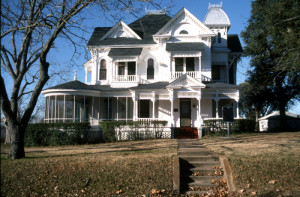
The Broyles Home Circa 1991, much as it looks today!
3. Palestine Michaux Historic District
“The southeast part of Palestine was sparsely populated until about 1915 when new economic growth in Palestine created the need and the means to pay for new housing. Housing here is mostly small and medium size one and two story wood or brick dwellings. Most are vernacular buildings. The Tudor Revival style John H. Reagan School, built in 1917 at 400 S. Michaux Avenue is one of the most visually imposing buildings in the southeast part of Palestine. The Michaux Historic District was created in 2009 to preserve the historic character of this predominately early 20th Century neighborhood.” -City Historical Preservation Committee Handbook
4. Downtown (Commercial Buildings) Historic District
Since the arrival of the railroad in 1872, the commercial center of the City of Palestine has been the downtown area. Composed primarily of late 19th and early 20th Century commercial buildings, the downtown area referred to as “New Town” by local residents, has always provided goods, services and entertainment to the residents occupying the upper floors of these commercial buildings, surrounding neighborhoods, as well as the many visitors to the city drawn by the economic opportunities provided by the railroad industry. The downtown historic district was created in 1992, to preserve this area, and the Palestine Main Street Program assists property owners in this area to promote economic revitalization and growth within this district, which is the historical center of commercial activity and urban life in the City of Palestine. Click here to download the Palestine Chamber's Downtown Palestine Tx Self-Guided Walking Tour Brochure.

